Key takeaways:
- Custodial wallets offer simplicity and customer support but require trust in third parties, raising concerns about control over assets.
- Non-custodial wallets provide full control and enhanced privacy, empowering users but also demanding greater responsibility and awareness.
- Choosing a wallet involves considering personal priorities such as ease of use versus asset control and the importance of community support.
- Experiences with custodial wallets reveal the tension between convenience and control, while non-custodial wallets emphasize the need for diligence in managing security.
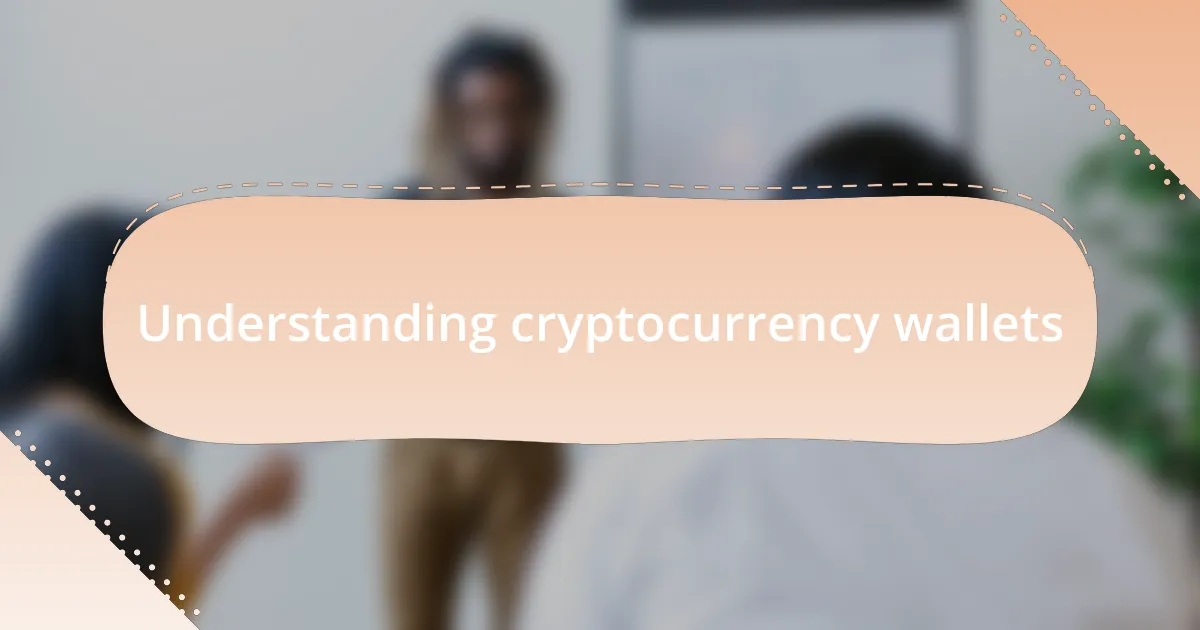
Understanding cryptocurrency wallets
Cryptocurrency wallets are essential tools for anyone looking to engage with digital currencies. They serve as the bridge between you and the blockchain, allowing you to send, receive, and store your assets securely. I remember the first time I set up my wallet; the mix of excitement and apprehension was palpable. Would I really grasp everything about it, or would I end up losing my funds in cyberspace?
When we discuss custodial versus non-custodial wallets, it’s crucial to consider the level of control each provides. Custodial wallets are managed by third parties, which might sound convenient but also raises questions about trust. I used a custodial wallet in my early days, and while it was user-friendly, I often felt like I was giving up too much control. The moment I ventured into non-custodial wallets, the freedom was exhilarating. I felt like I took back the reins of my financial journey.
Understanding the nuances between these wallet types is not just a technical exercise; it’s about your security and peace of mind. What do you value more: ease of use or control over your assets? This is a personal decision that can significantly impact your crypto experience. I learned that the right choice for me was a non-custodial wallet, giving me the autonomy I craved in a world that often feels unpredictable.
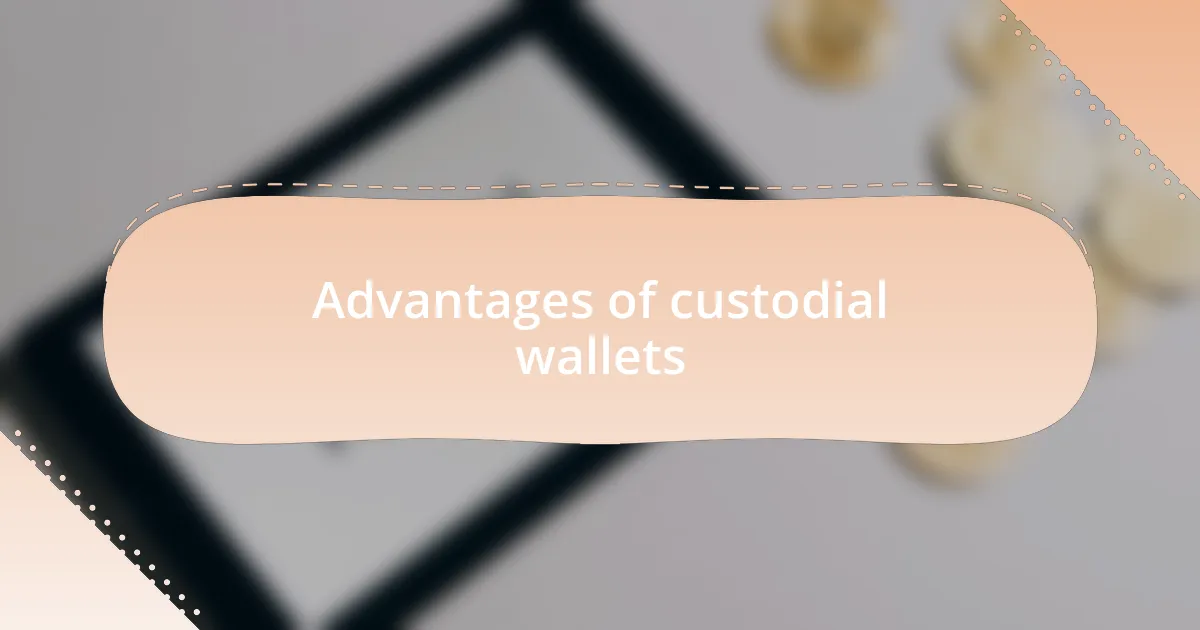
Advantages of custodial wallets
When I first started using custodial wallets, one of the standout advantages was their simplicity. The interfaces are often designed with beginners in mind, which made it easy for me to execute transactions without feeling overwhelmed by technical jargon. I remember feeling an instant sense of relief; no need to memorize crypto addresses or worry about private keys—everything was managed for me.
Another significant benefit I noticed was the customer support available with custodial wallets. During my early experiences, I ran into a few hiccups while transferring funds. Having a support team to assist me was invaluable. It helped ease my anxiety when things didn’t go as planned, and I realized that this safety net can be a crucial factor for anyone just starting their crypto journey.
Lastly, custodial wallets often provide additional security features like two-factor authentication. The idea that my assets were guarded by strong security protocols allowed me to engage with cryptocurrencies confidently. I often found comfort in knowing that a professional team was taking care of my security, which let me focus on learning about trading and investing rather than worrying about potential breaches.
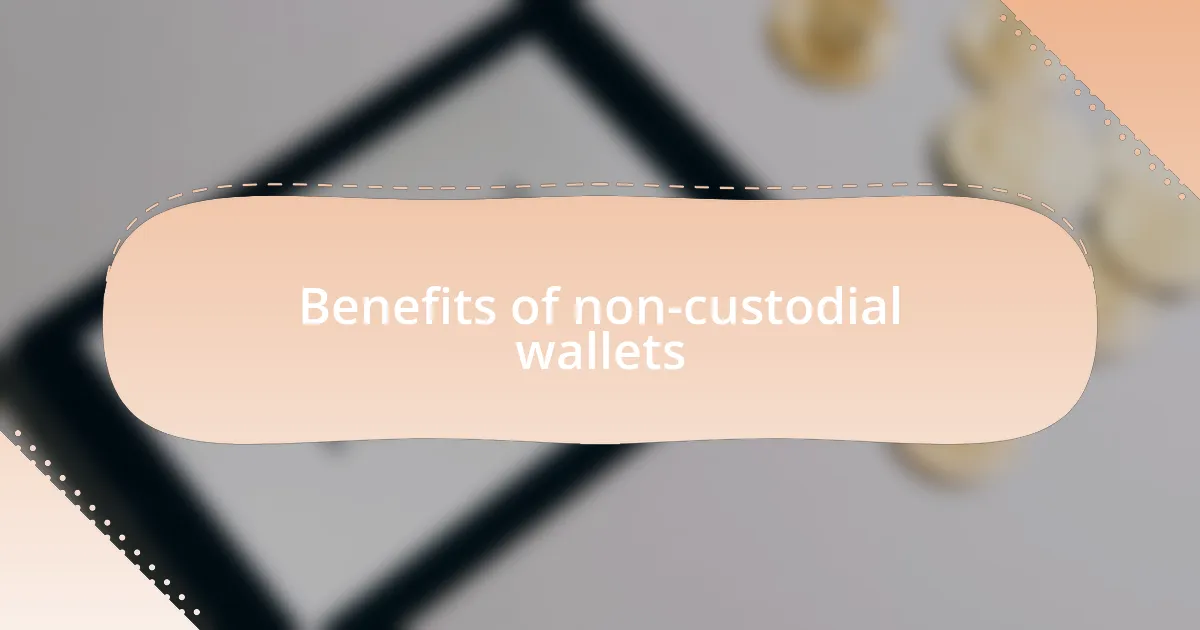
Benefits of non-custodial wallets
When I transitioned to non-custodial wallets, I was struck by the ultimate sense of ownership they provided. Unlike custodial wallets, I was in full control of my private keys. The first time I held my own keys, I felt a thrilling rush of empowerment. It’s like having the title to my property instead of renting it; there’s security in knowing that my funds are truly mine, untouchable by third parties.
Another substantial benefit that stood out to me was the enhanced privacy. With non-custodial wallets, I had the ability to make transactions without disclosing my personal information. I remember the relief it brought me when I realized I could engage with the blockchain without worrying about my data being stored or sold to advertisers. It felt liberating to participate in the crypto world on my own terms, don’t you think?
Moreover, the potential for lower fees was another appealing aspect. Many non-custodial wallets allow for direct transaction management, which often leads to reduced costs. When I first made a transfer and noticed the decreased fees compared to my custodial experiences, it was a game-changer. Saving money on transaction fees allowed me to invest more into my crypto portfolio, making my journey even more gratifying.
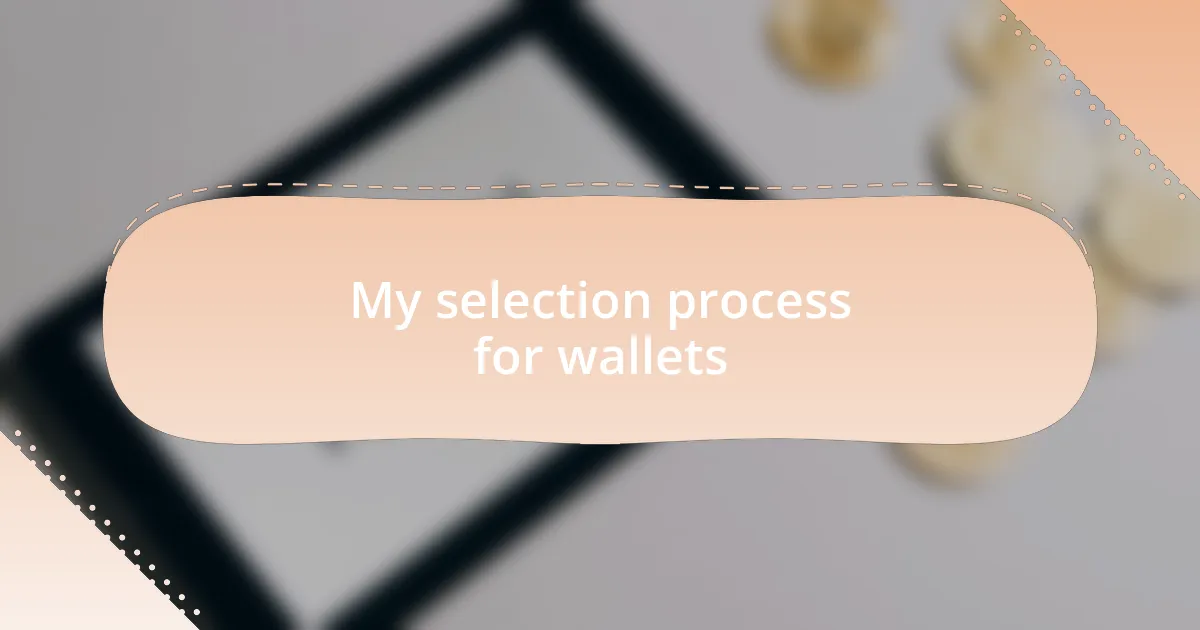
My selection process for wallets
When selecting a wallet, I first considered the level of control I wanted over my assets. I vividly recall my decision-making moment, sitting at my desk, weighing the freedom of a non-custodial wallet against the convenience of a custodial one. I asked myself, “How comfortable am I with managing my own security?” The realization that I could take full responsibility ignited a determination in me to dive deeper into the world of non-custodial options.
Next, I evaluated the user interface and overall experience each wallet offered. I still remember my frustration with complicated processes that seemed to deter my enthusiasm for crypto. After testing a few wallets, I fell in love with one that had a clean design and intuitive features. It made me think: why should managing my finances feel cumbersome? This upgrade transformed my daily interactions with crypto, fueling my excitement to explore further.
Finally, I considered the community and support around each wallet. During my early days, I found solace in forums filled with users sharing insights and troubleshooting tips. There was one wallet whose active community really stood out to me; I cherished the shared experiences and the camaraderie. This social aspect reassured me I wasn’t navigating these waters alone—who wouldn’t find comfort in that?
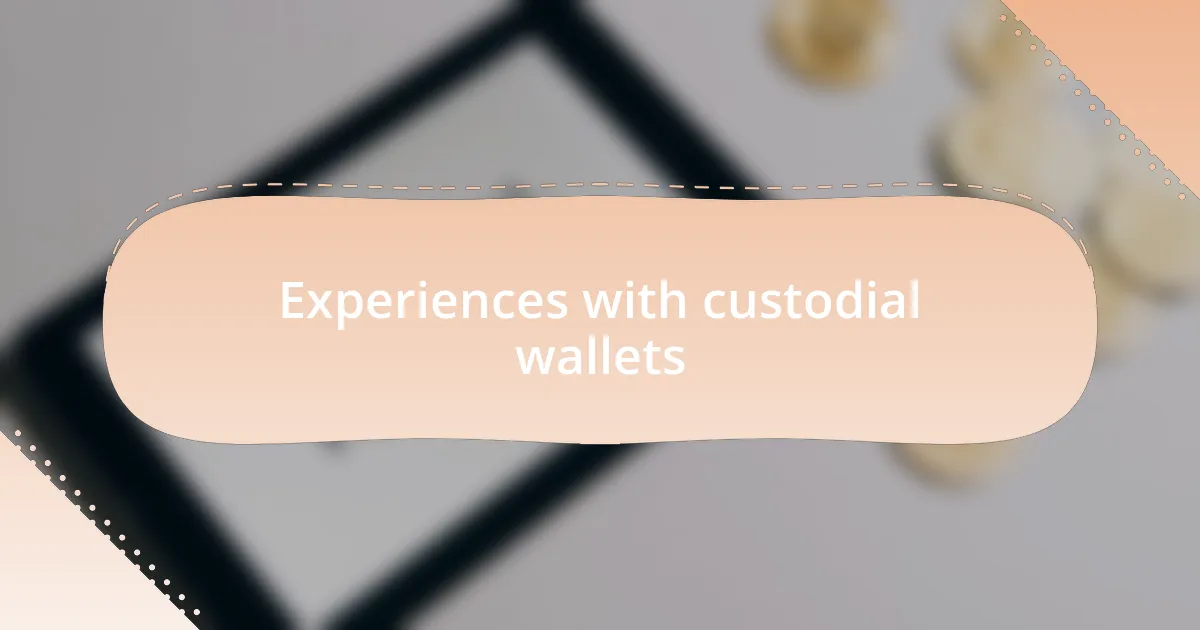
Experiences with custodial wallets
I’ve had a mix of experiences with custodial wallets, some of which were a bit eye-opening. I remember the first time I used one; it felt like a safe haven for my crypto. I appreciated the simplicity—I could focus on trading without the constant worry of managing private keys or dealing with complex security measures. But then, I started to wonder: what happens if that platform goes down, or worse, if they experience a security breach? That thought nagged at me.
As I continued my journey, I encountered the customer service aspect of custodial wallets, which was a double-edged sword. On one hand, I valued the support; when I had questions about a transaction, I knew there was a team ready to assist. Yet, it also made me uneasy. I longed for direct control over my assets, especially after hearing stories of users who faced long waits to get their accounts unlocked or funds released. The balance of convenience versus control felt like a constant tug-of-war within me.
Most vividly, I recall the moment I tried withdrawing funds from a custodial wallet during a market surge. The process was anything but seamless. While I sat anxiously, waiting for my transaction to go through, I questioned if I had placed my trust in the right hands. This experience solidified a key takeaway in my crypto journey: while custodial wallets offer ease and support, they come at the cost of personal control—an essential factor to consider in the pursuit of financial freedom.
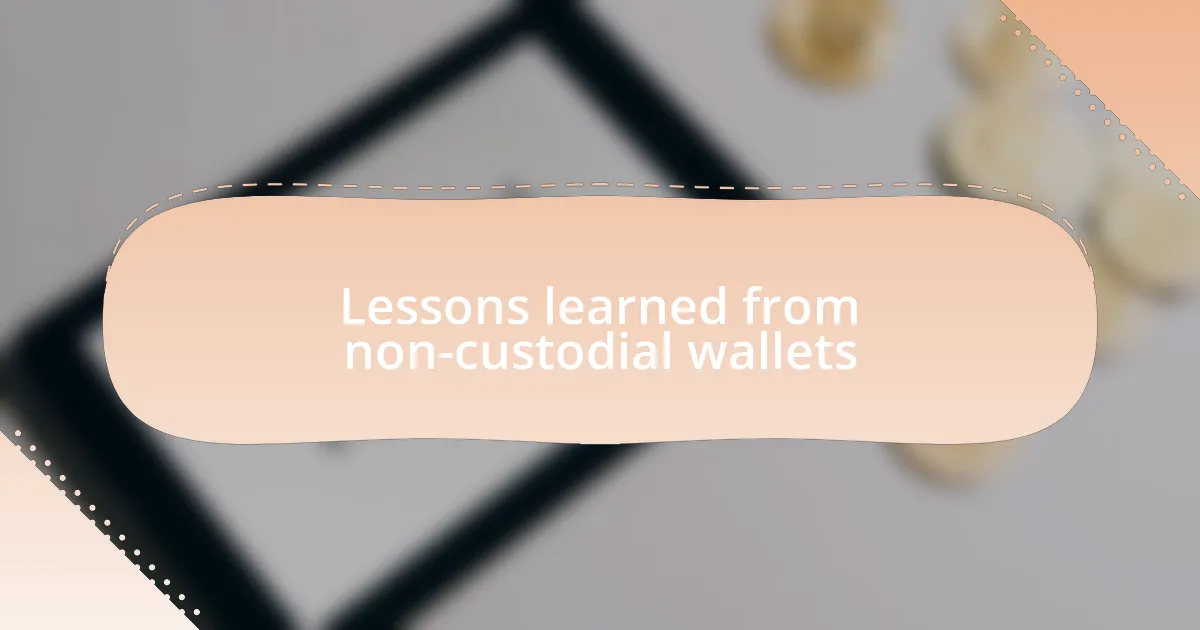
Lessons learned from non-custodial wallets
Switching to non-custodial wallets was truly a transformative experience for me. The first time I managed my private keys, I felt a rush of empowerment. I finally had full control over my assets, which gave me a sense of security like never before. But it also raised questions about responsibility—what if I lost my keys? That fear kept me on my toes and forced me to develop better habits around security.
However, managing a non-custodial wallet wasn’t always smooth sailing. I vividly remember a moment when I almost panicked after mistakenly sending cryptocurrency to the wrong address. The lack of customer support in a non-custodial environment became glaringly obvious. It hit home that the stakes were higher; I had to be diligent with every transaction. I learned that this freedom comes with the necessity for caution and awareness—each decision is solely mine to make.
I quickly realized that non-custodial wallets often require a deeper understanding of the technology. I found myself absorbed in articles and tutorials, trying to grasp the nuances of blockchain operations. This journey transformed my perspective; I felt like I was not just a user, but an active participant in the ecosystem. I often reflect on the question: am I ready to take full responsibility for my financial journey? The answer has consistently been yes, as I embraced the challenges and rewards of ownership.